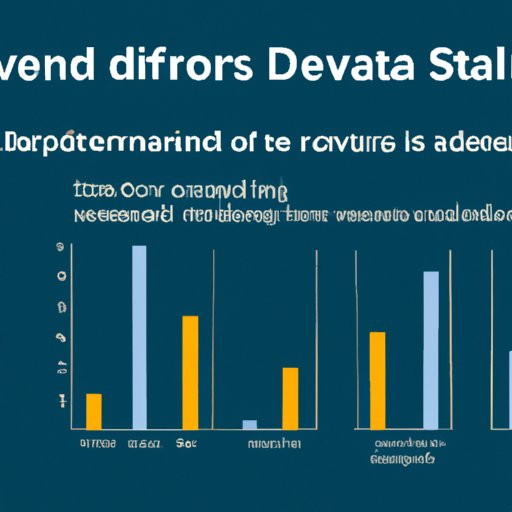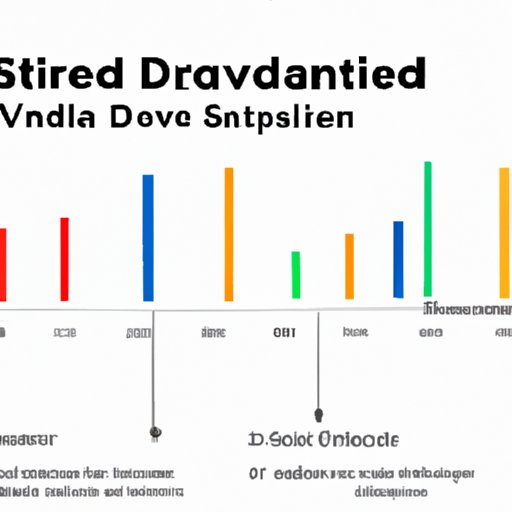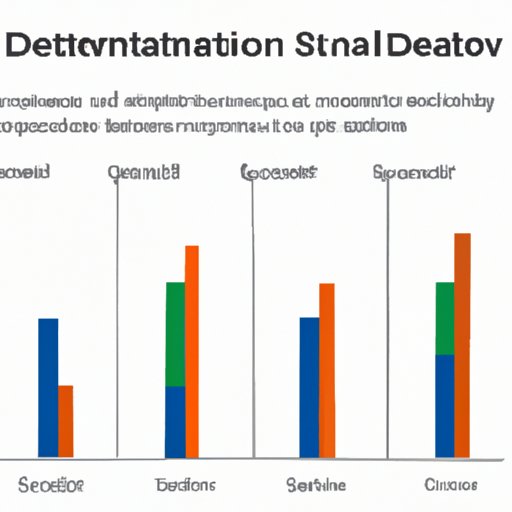Introduction
Standard deviation is a measure of the spread of values in a dataset. It is a key concept in data science, as it allows us to understand the variability of a dataset and make informed decisions about the data. In this article, we will explore what standard deviation is, why it is important in data science, and how to calculate it.

Explaining Standard Deviation with Examples from Data Science
Standard deviation is a measure of how much the values in a dataset vary from the mean. To calculate the standard deviation of a dataset, you subtract each value from the mean and then square the differences. The sum of these squared differences is then divided by the number of values in the dataset. This gives you the variance, which is the average of the squared differences. The standard deviation is the square root of the variance.
For example, if you had a dataset of five numbers (1, 2, 3, 4, 5), the mean would be 3. To find the standard deviation, you would subtract each number from the mean and square the differences. This would give you the following results: (-2)² = 4, (-1)² = 1, (0)² = 0, (1)² = 1, (2)² = 4. The sum of these squares is 10, so the variance is 10/5, or 2. The standard deviation is the square root of the variance, so in this case it would be the square root of 2, or approximately 1.41.
It’s important to note that standard deviation is not the same as other measures of variability. For example, range is the difference between the highest and lowest values in a dataset, while interquartile range (IQR) is the difference between the 75th and 25th percentiles. Both of these measures provide information about the spread of values in a dataset, but they are not the same as standard deviation.
How Standard Deviation is Used to Measure Variability in Data Science
Standard deviation is often used to measure the variability of a dataset. This is important in data science because it allows us to identify patterns in the data and make decisions about the data. For example, if two datasets have similar means but different standard deviations, we can use the standard deviation to determine which one has more variability.
In addition, standard deviation can be used to compare different datasets to see how similar or different they are. For example, if two datasets have similar means but different standard deviations, we can use the standard deviation to determine which one has more variability. This can be useful for making decisions about which dataset to use for a particular analysis.
However, it’s important to keep in mind that standard deviation is not always an accurate measure of variability. For example, if a dataset has a few outliers, the standard deviation may be artificially inflated. As such, it’s important to be aware of the limitations of standard deviation as a measure of variability.
A Step-by-Step Guide to Calculating Standard Deviation in Data Science
Calculating standard deviation in data science is relatively straightforward. The first step is to calculate the mean of the dataset. Once you have the mean, you can then subtract each value from the mean and square the differences. The sum of these squared differences is then divided by the number of values in the dataset, giving you the variance. Finally, the standard deviation is the square root of the variance.
There are various programming languages that can be used to calculate standard deviation, including R, Python, and SAS. Below is an example of how to calculate standard deviation using R:
# Create a vector of values
x <- c(1,2,3,4,5)
# Calculate the mean
mean <- mean(x)
# Subtract each value from the mean and square the difference
diff_squared <- (x - mean)^2
# Calculate the variance
variance <- sum(diff_squared)/length(x)
# Calculate the standard deviation
sd <- sqrt(variance)
It's also important to keep in mind that there may be errors when calculating standard deviation. To troubleshoot these errors, it's helpful to double-check the calculations and ensure that all values are correctly entered into the formula.

Understanding the Role of Standard Deviation in Data Science Analysis
Standard deviation is an important concept in data science, as it allows us to understand the variability of a dataset and make informed decisions about the data. By understanding how standard deviation works, we can compare different datasets to see how similar or different they are, and use this information to make decisions about which dataset to use for a particular analysis.
For example, if two datasets have similar means but different standard deviations, we can use the standard deviation to determine which one has more variability. This can be useful for making decisions about which dataset to use for a particular analysis.
In addition, understanding the role of standard deviation can help us identify patterns in the data and make better decisions. For example, if a dataset has a few outliers, the standard deviation may be artificially inflated. By understanding the limitations of standard deviation, we can make better decisions about the data.
Conclusion
Standard deviation is a key concept in data science, as it allows us to understand the variability of a dataset and make informed decisions about the data. In this article, we explored what standard deviation is, why it is important in data science, and how to calculate it. We also discussed how standard deviation can be used to measure variability in datasets and the importance of understanding its role in data science analysis.
By understanding standard deviation, we can make better decisions about the data and improve our data science analysis. Understanding the role of standard deviation is essential for any data scientist, as it can help them make better decisions about the data and identify patterns in the data.
(Note: Is this article not meeting your expectations? Do you have knowledge or insights to share? Unlock new opportunities and expand your reach by joining our authors team. Click Registration to join us and share your expertise with our readers.)
